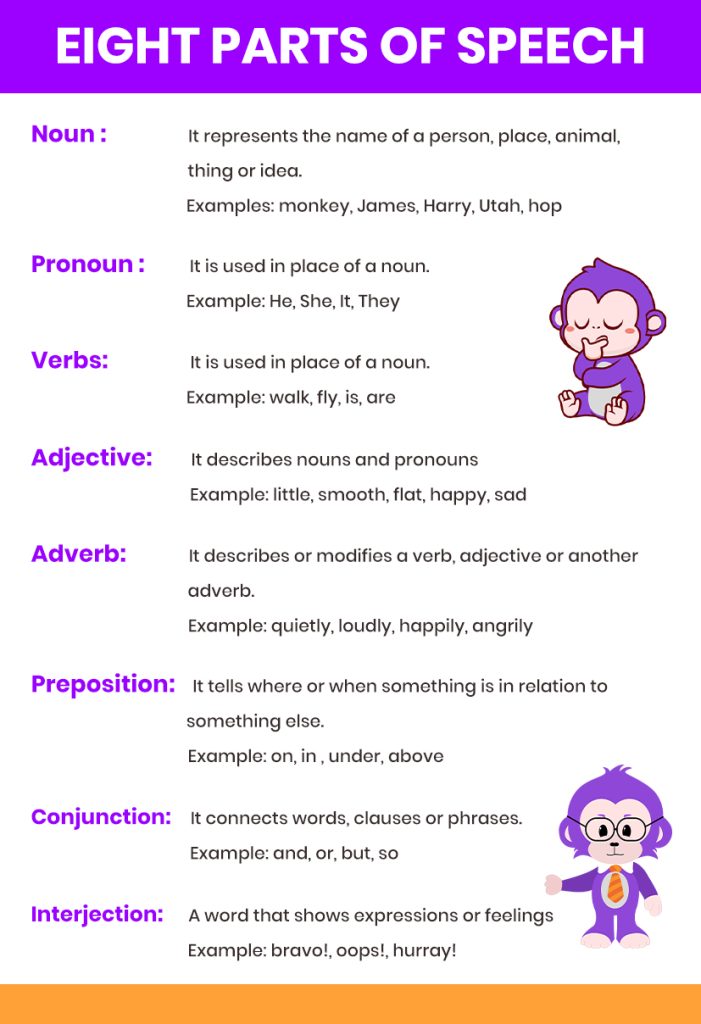The 8 Parts of Speech – Types and Examples
Introduction
Parts of Speech
In the realm of language and grammar, the concept of the eight parts of speech forms the foundation of understanding how words function within sentences. Each part of speech plays a unique role in conveying meaning and structure in communication. Let’s dive into the world of nouns, pronouns, verbs, adverbs, adjectives, prepositions, conjunctions, and interjections to gain a comprehensive understanding of their significance in language.
Analogy of Definition
The Eight Parts of Speech
The eight parts of speech are the building blocks of language, encompassing different categories of words that serve specific purposes in sentences. These parts include nouns, pronouns, verbs, adverbs, adjectives, prepositions, conjunctions, and interjections. Each part of speech has distinct characteristics and functions, contributing to the overall structure and meaning of sentences.
Method
Understanding Each of the Eight Parts of Speech
Nouns
Nouns are one of the eight parts of speech that represent people, places, things, or ideas. They can function as the subject or object of a sentence. Nouns can also be categorized into different types such as proper nouns and common nouns.
Examples include:
- The dog barked loudly in the park.
- My friend and I went to the movies yesterday.
- The sun set behind the mountains, casting a warm glow.
- I bought a new book at the bookstore downtown.
Read more about Nouns.
Pronouns
Pronouns are words that replace nouns to avoid repetition. It allows us to substitute nouns, which helps reduce repetitions. They include words like “he,” “she,” “it,” “they,” and “we.”
Examples include:
- He is going to the store to buy groceries.
- She likes to read books in her free time.
- They are coming over for dinner tonight.
- I saw him at the park playing basketball.
Verbs
Verbs are action words that express an action, occurrence, or state of being. They are essential for forming sentences as they represent not just actions but also feelings and states.
Examples include:
- The coffee smells amazing in the morning.
- She knows the answer to the question.
- The sun shines brightly in the sky.
- They play soccer every weekend.
- She sings beautifully in the choir.
Read more about Verbs.
Adverbs
Adverbs modify verbs, adjectives, or other adverbs, providing information about the manner, time, place, or degree of an action or description.
Examples include:
- She spoke loudly during the presentation.
- I will meet you soon at the cafe.
- The cat climbed gracefully up the tree.
- He reads slowly to comprehend the text.
Adjectives
Adjectives modify or describe nouns and pronouns, adding detail and specificity to the words they modify.
Examples include:
- The blue sky was clear and beautiful.
- She wore a elegant dress to the party.
- The big elephant trumpeted loudly.
- We live in a cozy little cottage.
Prepositions
Prepositions show the relationship between a noun or pronoun and other words in a sentence. They often indicate location, direction, time, or spatial relationships.
- The cat is on the roof.
- We went for a picnic in the woods.
- She sat beside her friend.
- The keys are under the mat.
Conjunctions
Conjunctions connect words, phrases, or clauses within a sentence. They can be coordinating, subordinating, or correlative.
- He likes to play soccer and basketball.
- I will study hard so I can pass the exam.
- The cat ran away when the dog barked loudly.
- We can go to the movie if you finish your homework.
Interjections
Interjections are words or phrases used to express strong emotions or sentiments, often appearing in exclamatory sentences.
- Wow, that was an amazing performance!
- Ouch! I accidentally bumped my knee against the table.
- Oh no, I forgot to turn off the stove.
- Yay, we won the game!

Examples
Identifying the Parts of Speech in Sentences
Sentence: The quick brown fox jumps over the lazy dog.
Parts of Speech:
Noun: fox, dog
Pronoun: The
Verb: jumps
Adverb: quick, over, lazy
Adjective: brown
Preposition: over
Conjunction: and
Interjection: None in this sentence
Sentence: Oh no, the clever and curious cat quickly climbed the tall tree, only to realize it was a tricky challenge.
Parts of speech:
- Interjection: Oh no
- Pronoun: it
- Adjective: clever, curious, tall, tricky
- Adverb: quickly
- Noun: cat, tree, challenge
- Verb: climbed, realize, was
- Preposition: to
- Conjunction: and
Quiz
Tips and Tricks
1. Noun
Tip: Look for words that represent people, places, things, or ideas to identify nouns in a sentence. Nouns are usually followed by an article such as ‘a’, ‘an’, and ‘the’.
2. Pronoun
Tip: Use pronouns to replace nouns and avoid repetition in sentences, ensuring clarity and flow in communication. Pronouns replace nouns, so look for words that refer back to a previously mentioned noun.
3. Verb
Tip: Look for action words that express an action, occurrence, or state of being to identify verbs in a sentence. Identify what the subject is doing or the state it’s in.
4. Adverb
Tip: Adverbs provide information about the manner, time, place, or degree of an action or description, enhancing the details in a sentence. Adverbs often end in “-ly,” but not always. Look for words that modify verbs, adjectives, or other adverbs.. Ask questions like “how?” “when?” or “where?” to identify adverbs.
5.Conjunction
Tip: Conjunctions connect words, phrases, or clauses within a sentence, facilitating the flow and coherence of the text. Words like and, but, or, so, for, nor, yet are often conjunctions.
Real life application
Story: “The Language Journey of Sam and Maya”
Sam and Maya, two enthusiastic language enthusiasts, embarked on a journey to explore the practical applications of the eight parts of speech in real-life scenarios.
Scenario 1: The Creative Writing Challenge
Sam and Maya participated in a creative writing competition where they had to craft a compelling story using a variety of adjectives, adverbs, and conjunctions to enhance the narrative. By incorporating vivid descriptions and seamless transitions, they showcased the power of these parts of speech in creating engaging storytelling.
Scenario 2: The Public Speaking Showcase
In a public speaking event, Sam and Maya delivered persuasive speeches that utilized strong verbs and impactful interjections to captivate the audience. Their dynamic use of language and expressive delivery highlighted the influence of these parts of speech in effective communication.
Scenario 3: The Grammar Workshop
As language mentors, Sam and Maya conducted a grammar workshop to help students understand the importance of nouns, pronouns, and prepositions in constructing clear and coherent sentences. Through interactive activities and engaging examples, they demonstrated the fundamental role of these parts of speech in language structure.
FAQ's
Like? Share it with your friends






